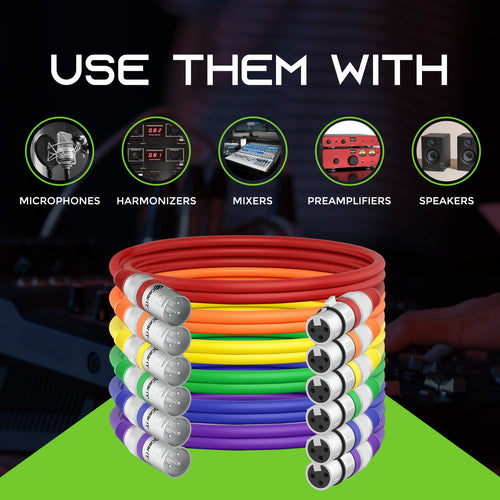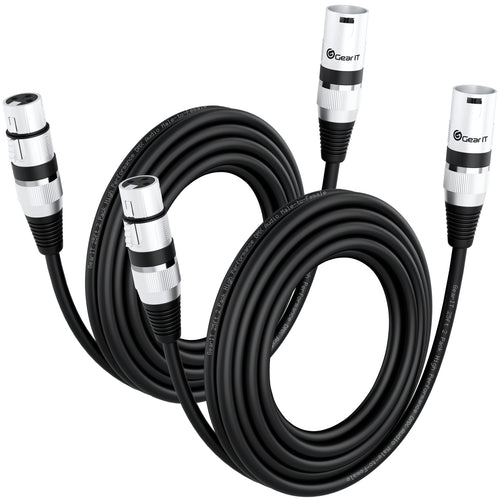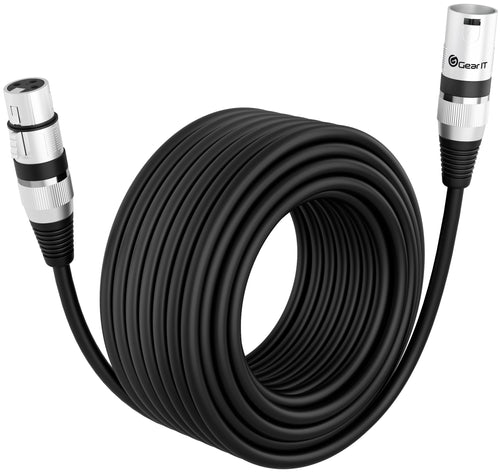In the audio/visual world, there are several different types of cables with varying connectors. They may have different functions but sometimes can be interchangeable. If you are new to using audio or lighting equipment, you likely have heard of a DMX cable but may not understand its relation to an XLR cable. This brief guide will help you differentiate between the two so you can find the right cables for your project.
What Is a DMX Cable?
DMX stands for Digital Multiplex, the standard digital communication protocol used to connect lighting fixtures with remote-control intelligence. For example, an LED lighting system typically has a remote control feature with a power controller connected by DMX cables.
Depending on the model and manufacturer, a DMX controller can feature wheels, buttons, faders, and touch screens to use to control the display of your light fixture. A single console can control multiple light fixtures by connecting everything with DMX cables.
These cables were based on the XLR cable, making them similar but not necessarily interchangeable. A DMX cable is intended for lighting fixtures, while you can get the most out of XLR cables when using them to connect audio equipment.
What Is an XLR Cable?
XLR cables carry audio signals through various equipment, such as microphones, amplifiers, mixers, and soundboards. In audio/visual work, you typically see an XLR cable connected to a microphone, an object that requires an analog function.
XLR cables require a lower voltage than DMX cables and are structurally more rugged. For example, they have a wider diameter and thicker shield to accommodate rough usage and frequent movement. If you need to connect a microphone with a cable, an XLR cable allows you to drag it along the floor during a show without damaging it.
Is a DMX Cable Interchangeable With an XLR Cable?
One significant difference between DMX and XLR cables is their ohm requirements. Ohm's law concerns the relationship between a substance and a current. Simply put, ohm measures impedance, the change in voltage per unit charge needed to send a signal down a wire, for example, to make a lighting fixture do what you told it to do through the controller.
Since DMX cables require 110 ohms and XLR cables only require up to 75 ohms, using them interchangeably is not typically advisable. Even if a device seems to work fine when you plug them in, issues may present at any time during a show or event. Potential complications for cross-use include the following:
- • Interruptions in the transfer of data: Because the two types of cables cannot carry the same voltage, using an XLR cable could cause a light display to be weaker.
- • Noise interference: The two types of cables have different shielding. Therefore, connecting a DMX cable to a microphone, for example, could disrupt sound quality.
- • Aesthetic and durability issues: XLR cables are thicker and bulkier, making them harder to hide in a lighting fixture. DMX cables are not as rugged, making them less durable when attached to a microphone.
Using DMX and XLR cables interchangeably will likely not damage your lighting fixture or your microphone equipment. However, it can cause signal disruptions unless you use DMX cables that specify XLR compatibility. Ultimately, the DMX standard made using XLR cables for lighting and many other visual needs obsolete, but XLR may still be useful for audio equipment. A well-equipped audio/visual team should have both types of cabling.
How Are XLR and DMX Cable Connectors Different?
Connectors are the male and female ends of cables that plug into the equipment. Using the correct connector is important for optimal equipment safety and usage.
The DMX standard has more specific cable connectors than XLR, which have a variety of connector types to accommodate additional signals. You can even find mini XLR connectors for devices that are too small to fit a standard XLR connector.
DMX Connectors
DMX connectors and cabling is an adaptation of XLR cabling adjusted to make it more compatible with lighting systems. Therefore, the connectors for both are similar. For example, the most common versions of DMX and the XLR connectors have three pins.
The connector for the DMX cable can only have between three and five pins, and pin placement can come in three different types:
- 1. The 180-degree layout features five pins in a tight half-circle or arch.
- 2. The 240-degree layout places five pins in an arch-like shape similar to the 180-degree connector, but spreading the pins further apart.
- 3. The 270-degree connector has five pins arranged like the five face on the side of dice.
The most common version of a DMX connector with five pins is the 180-degree formation. However, manufacturers sometimes leave two pins unwired, since three is often sufficient.
XLR Connectors
XLR connectors come in the same formations as DMX cables. However, they can have up seven pins depending on the intended function. For example, a seven-pin connector is useful for certain types of equipment, such as a fog machine, and prior to the advent of DMX cables, it was the best option for carrying analog lighting control signals.
What Should You Look For in a DMX Cable?
Before making a purchase for a lighting project, whether it is a small-scale fixture at home or a large work project, consider the scope of the job. Ask yourself a few questions:
- 1. How long does the cable need to be? Always measure all dimensions before buying.
- 2. How many cables do you need? Multi-packs can sometimes save you money.
- 3. How many pins do you need in the connector? For example, the XLR-compatible DMX Male to DMX Female Stage Lighting Cable by GearIT comes with two cables and has the standard three pins.






















































